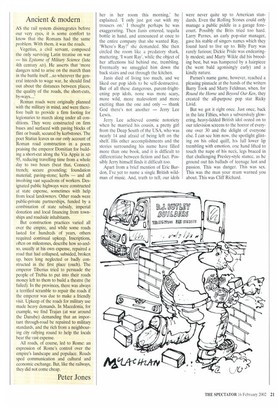Ancient & modern
AS the rail system disintegrates before our very eyes, it is some comfort to know that the Romans had the same problem. With them, it was the roads.
Vegetius, a civil servant, composed the only surviving Latin treatise on war — his Epitome of Military Science (late 4th century AD). He asserts that 'more dangers tend to arise on the march than in the battle itself ...so wherever the general intends to wage war, he should find out about the distances between places, the quality of the roads, the short-cuts, by-ways....'
Roman roads were originally planned with the military in mind, and were therefore built to provide a firm footing for legionaries to march along under all conditions. They were constructed on firm bases and surfaced with paving blocks of flint or basalt, secured by kerbstones. The poet Statius leaves us our only account of Roman road construction in a poem praising the emperor Domitian for building a short-cut along the Via Appia in AD 95, reducing travelling time from a whole day to two hours (beat that, Connex): trench; secure grounding; foundation material; paving-stone; kerbs — and all involving vast squadrons of workers. Designated public highways were constructed at state expense, sometimes with help from local landowners. Other roads were public-private partnerships, funded by a combination of state subsidy, imperial donation and local financing from townships and roadside inhabitants.
But construction practices varied all over the empire, and while some roads lasted for hundreds of years, others required continual upkeep. Inscriptions, often on milestones, describe how so-andso, usually at his own expense, repaired a road that had collapsed, subsided, broken up, been long neglected or badly constructed in the first place (ouch). The emperor Tiberius tried to persuade the people of Trebia to put into their roads money left to them to build a theatre (he failed), In the provinces, there was always a terrified scramble to repair the roads if the emperor was due to make a friendly visit. Upkeep of the roads for military use made heavy demands. In Macedonia, for example, we find Trajan (at war around the Danube) demanding that an important through-road be repaired to military standards, and the rich from a neighbouring city rallying round to help the locals bear the vast expense.
All roads, of course, led to Rome: an expression of Rome's control over the empire's landscape and populace. Roads sped communication and cultural and economic exchange. But, like the railways, they did not come cheap.
Peter Jones




































































 Previous page
Previous page